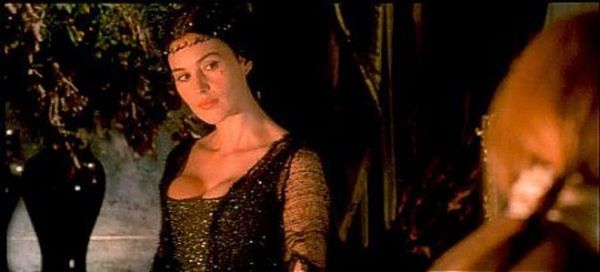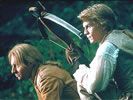Eye For Film >> Movies >> Brotherhood Of The Wolf (2001) Film Review

Between the years 1764 and 1767, villagers living in the Margatide Mountains in France reported a series of animal attacks whose ferocious nature so shocked the country that their assumed perpetrator took on a legendary status still well known today: the Beast of Gévaudan. Generally believed to have been a wolf, or perhaps a small family of wolves, it killed as many as 113 people and injured many more, generally preferring to attack solitary individuals or those who looked vulnerable, such as children. Its death is usually attributed to local hunter Jean Chastel, though it was thought to have been killed several times before, with one body even stuffed and taken to Paris to be exhibited in the royal court. At this pivotal time in French history, the perceived failure of the King’s forces to protect the people of Gévaudan contributed to a growing resentment whose eventual expression continues to echo through world politics to this day.
Though not by any means the first film to deal with this subject matter, Christophe Gans’ 2001 actioner marked quite a departure for French cinema, and remains to this day a rare example of (comparatively) big budget populist far from a country which prides itself on its intellectual auteurs. It does not pretend to be a direct retelling of the Gévaudan legend, inventing characters and putting its own distinct spin on the story, but it does weave in historical events. Recounted by a curiously aged aristocrat who is preparing to give himself up to a revolutionary mob, it attempts to tie together the Beast with the revolution of 1789 and, by way of including an Iroquois character, with wider events on the geopolitical stage. It bites off far more than it can chew, but the result is still interesting and, in places, gripping viewing.

At the centre of it is Grégoire de Fronsac (Samuel le Bihan), a physician, explorer and notorious libertine dispatched to the remote rural province to investigate the killings. He is accompanied by Mani (Mark Dacascos), the aforementioned Iroquois man, who brings with him more unusual healing and fighting skills. This device enables Gans to set the stage in an early scene with a display of martial arts choreographed by Hong Kong legend Phillip Kwok. Though sometimes criticised as cheesy and out of place, it’s worth remembering that this film was being made at the same time as The Matrix, which just pre-empted it in introducing this kind of fight scene to the Western mainstream. Its use of slow-motion has been heavily parodied since but back then it was exciting for unfamiliar audiences to watch, and it helped to establish Mani as an unknown quantity who just might be a match for the unknown powers of the Beast.
Alongside monster-hunting, de Fronsac has other things on his mind, romancing Marianne (Émilie Dequenne), the esteemed daughter of the local count, and spending his spare time in a brothel with the mysterious Sylvia (Monica Bellucci). Without social status of the ordinary kind, Sylvia wields power through other means, collecting secrets and whispering in the ears of men of influence, but her agenda remains uncertain for much of the film’s running time. Also significant in the unfolding story are the local priest Sardis (Jean-François Stévenin), who tells his frightened flock that the Beast’s presence has been occasioned by their sin; and Marianne’s brother Jean-François (Vincent Cassel), who, like de Fronsac, is an experienced hunter who has spent time in Africa.
At two hours and 22 minutes (having been whittled down considerable to get there), the film risks exhausting its audience, though the more general increase in running times means that that’s likely to be less of a problem today than it was in 2001. It is never slow, with more than enough plot to fill that time. Some critics have described it as overly contrived, which, in light of the literature popular in France at that time, is rather a delightful conceit. There are elements of action, espionage, period drama, religious critique and detective story, as well as an effort to address the complex racial politics of the time. Central to the latter, of course, is Mani, and Dacascos’ performance is one of the highlights of the film. His ability to convey superior intelligence with a glance recalls Sidney Poitier, and he gets some of the film’s best lines.
If you are watching the original version of the film with English subtitles, you will find poor translation an issue. Most notably, there is no implication in the French that the Beast is female (at least not until very late in the film, when it is addressed directly) – the translator simply hasn’t understood when to use a non-gendered third person pronoun. This is a minor issue, however, and shouldn’t interfere too much with your enjoyment of the whole. Messy though it may be, there is a lot to recommend this ambitious and colourful film.
Reviewed on: 14 May 2023




















